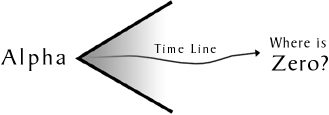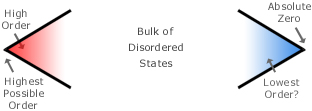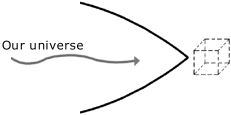|
"
We will first understand how simple the universe is when we recognize how strange time is."—J. A. Wheeler
From The Book:
Everything Forever:
Learning to
See Timelessness
"Most physicists feel that the ultimate theory should have no input parameters, no fundamental dimensionless constants, and that all the masses of quarks, and all coupling strengths, should be predicted by such a master theory."
—Heinz R. Pagel
"In the Original Unity of the First Thing lies the Secondary Cause of All Things, with the Germ of their Inevitable Annihilation."
—Edgar
Allen Poe
"One cannot help but be in awe when he contemplates the mysteries of eternity, of life, of the marvelous structure of reality."
—Albert Einstein

"Imagine you can play God and fiddle with the settings of the great cosmic machine. Turn this knob and make electrons a bit heavier; twiddle that one and make gravitation a trifle weaker. What would be the effect? The universe would look very different so different, in fact, that there wouldn't be anyone around to see the result, because the existence of life depends rather critically on the actual settings that Mother Nature selected."
—Paul Davies
A Brief History of the Multiverse
|
The imagination can easily create other worlds in fantasy. But do such worlds really exist? It seems that we have no way of knowing, unless perhaps there is an ultimate structure to the whole of all possibilities. We have already seen that the realm of possibilities is limited or bounded by the extremes of Alpha and Omega. Are there other limits? Indeed the whole of infinite possibilities has a distinct shape which can be understood. In fact there are boundaries in every direction of possibility, and such boundaries shape and guide the flow of time in our own universe. They influence and determine our entire lives. If we know what is possible we can determine what is probable. We all intuitively know this. If we could create a map of all possibilities such a map should tell us what worlds are probable and what worlds are improbable or impossible. We know that what is possible determines what actually happens in our own universe, but we only vaguely understand why. The physicist Ludwig Boltzmann was the first to imagine that an overall set of possibilities has a shape and structure that controls what happens in time when he developed an advanced theory of thermodynamics in 1868. In his now famous book, A Brief History of Time, the physicist Stephen Hawking uses a puzzle to explain the basic principles behind Boltzmann's statistical version of the second law. Hawking explains how the greater number of disordered states influences events. Note that each possible pattern or arrangement is called a state, and the overall realm of possibilities is called state space. Hawking writes: Consider the pieces of a jigsaw [puzzle] in a box. There is one, and is only one, arrangement in which the pieces make a complete picture. On the other hand, there are a very large number of arrangements in which the pieces are disordered and don't make a picture. Suppose the pieces of the jigsaw start off in a box in the ordered arrangement in which they form a picture. If you shake the box, the pieces will take up another arrangement. This will probably be a disordered arrangement in which the pieces don't form a proper picture, simply because there are so many more disordered arrangements. Each time we shake the box and look inside we discover
a new unique pattern where the puzzle is broken apart. In fact there is a seemingly endless number of possibilities
which are more disordered than the one most ordered pattern where all its pieces are fit perfectly together. Boltzmann
believed this is the reason why increasing disorder is much more probable than increasing order, because in selecting
the future, nature chooses among a larger pool of disordered states over ordered states. Some have even applied the thinking of Boltzmann to the large-scale realm of all possibilities. In the book, "The End of Time", the English physicist Julian Barbour portrays timelessness as a wedge shape originating from the Alpha state. Having named his model Platonia, Barbour writes, "Platonia is necessarily skew. It is easy to imagine that the cone 'funnels entanglement outwards', much like a trumpeter blows air from a bugle" (pg.321). This model of all possible states will be referred to as the wedge model. This is generally how we have come to view the general shape of all possibilities, dating back to the late 1950's when Eddington proposed a relationship between thermodynamics and the cosmological arrow of time. Several scientists have modeled the realm of possibilities in this same way, however, it is important to consider that scientists today are usually only considering the possible states that are directly available to a system (where the system obeys the laws of physics) so they are not attempting to model all conceivable possibilities from a top-down perspective as we are doing here.
What we are about to do now is take the wedge model and modify and mold it into a full and more detailed description of all possible states. The wedge model is very structured and precise in one direction, toward the Alpha state in our past, but it is non-descriptive of the future. Does the wedge accurately represent the structure of all possible states? Is there no structure or end to the measure of increasingly disordered patterns? The wedge model predicts the direction of time is toward disorder. For several years now scientists have been aware that time itself is accelerating toward absolute zero, and yet our modern vision of all possible states does not yet include any representation of zero. The wedge model obviously only includes one of the two cosmic absolutes which we know today exist in cosmology (see part one). The classic wedge model does not include the ultimate zero of physics. So our first step is to integrate zero into the wedge model.
That first step is easy enough, but it immediately leads to a few new questions. What is the shape of pattern space near zero? Suddenly we have to completely reconsider the wedge shape as a description of all possibilities. We know there exists an ever decreasing measure of states leading to the single Alpha state in our past. Those boundary conditions near Alpha actually are what define the wedge. They give shape to what is ultimately possible. Integrating zero doesn’t challenge those boundary conditions. It just leads us to consider new boundary conditions in the direction of our future that come along with zero. It is only natural that the same principles that apply to the Alpha extreme also apply to a zero extreme. Zero is also a single extreme state, a single condition, a singularity. It is a uniform state. So as we might expect, in moving toward that single extreme there is another wedge, a reversed wedge, on the other side of the great bulk of diverse states.
Zero is perfect symmetry. It is perfectly flat. It is the same everywhere. It is the template of sameness and symmetry. This necessitates that there are increasingly fewer states that are zero-like, that are almost flat, that are almost uniform. Consequently as we move nearer to zero the shape of state space closes and narrows inward toward the single state of zero. The overall measure of possibilities decreases. This forms a closing of possibilities in the direction of our future. Let’s recall here Stephen Hawking's analogy of the puzzle in the box. Every time we shake the box there is a new pattern. And there is only one pattern where all the pieces of the puzzle fit together. But there is also only one pattern where the box is empty. Furthermore, if we consider patterns where there are just two or three pieces in the box, there aren’t nearly as many unique patterns as there are with ten or fifty pieces in the box. As we take away puzzle pieces, there are fewer and fewer unique configurations, until finally there is just the one state of an empty box. It follows that the measure of possible states is naturally greatest when the box is not too full and not too empty. The same is true for the universe outside of the box. We can imagine that a large measure of unique possible states exist for the amount of galaxies that presently inhabit the universe, keeping in mind there are wide expanses of empty space between those galaxies, and that empty space would remain a constant for each possible state. If we then imagine adding galaxies into the measure of empty space, so that there were more galaxies in the same volume, as is increasingly true of the distant past, then we can easily recognize there would be a larger measure of possible states, since there are more galaxies in the same volume to alter into unique configurations. It follows that the measure of possible states is greatest somewhere in the middle in between Alpha and Omega where the greatest measure of diversity exists. In considering the distant future the same principles
which define the shape of the wedge model in our past apply also to the shape of state space near zero. As matter is
stretched flat and the density of space approaches zero there is an ever decreasing measure of unique patterns in that
direction. The nearer we are to zero the fewer possibilities exist that are zero-like. A wedge shape that contracts
toward Omega is the most important consequence of integrating zero into the set of all possible states. The shape of all
conceivable states is defined by two extremes, not one. And now we can see that there is a wide spectrum of patterns
ranging from infinite density to the zero density. This creates a density gradient.
Recognizing the reversed wedge shape of possibilities out there in our future is a big step forward. It carries with it some profound implications that are even immediately visible. Considering we are moving directly toward zero, even presently accelerating in that direction, a narrowing structure of possible states means that our universe is increasingly influenced and focused by the final condition at the end of time. It means that time will eventually be forced into a very limited and defining number of future possibilities. This funneling of time not only creates a considerable restriction to what is possible in the distant future, this funneling of time’s direction would even be influencing our present at this stage of cosmic evolution. Regardless of how many possibilities there are, if time is faced with ever fewer choices in the direction toward zero, then the future will naturally become increasingly determined or shaped by the availability of a fewer measure of patterns that exist in that direction. Considering how flat and empty the large-scale universe is at present, in the same way the past was focused outward by Alpha, as Barbour put it, “like a trumpeter’s horn”, our future is being increasingly channeled inward toward ZAT, so it is increasingly focused by, and made to be like zero, simply due to the narrowing of possibilities. Of course we are accustomed to the way zero is effecting our universe. In understanding that zero is the symmetry order extreme, and remembering how symmetry order supplies the component of balance to all patterns, we can realize that increasing balances are the result of time moving ever nearer to zero.
Figure
6: The shape of State Space near Zero. Omega is full and not empty. So what the narrowing wedge in our future means is that the universe and we ourselves in various ways are presently feeling the influence of the balanced whole. Rather all the various paths of time all have the same beginning and the same final destination. Consequently zero is influencing the present universe. One force of nature in particular, the great balancing force of electromagnetism, is clearly the product of our moving ever nearer to the balance and symmetry of zero. Later we shall give this focusing to the direction of time a great deal of further study since this influence from the future, combined together with the influence of the grouping order of our past, creates a wonderfully simple way of comprehending the forces of nature. However, before we are ready for that insight, we first need to more fully understand the shape of the possible realm. Now that we have considered the past and future, let’s take a look at those possibilities that exist adjacent the present. Next page: The Adjacent Possible
Taken from Chapter Twelve from the book Everything Forever. Contents This page last updated Mar 25th, 2007 |
| Your welcome to send an e-mail and share your thoughts when you're done reading. |
|
Homepage | Part One | Part Two | Part Three | Part Four | Part Five | Contents | Backward | Forward | |
|
© Gevin Giorbran, Copyright 1996 - 2007 All rights reserved. Privacy Policy | Usage Policy |
|
|
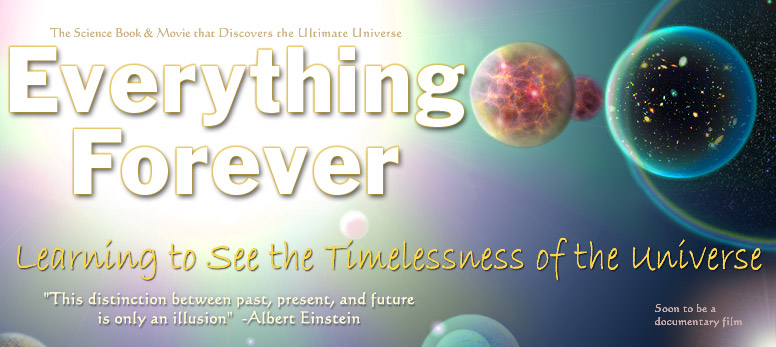
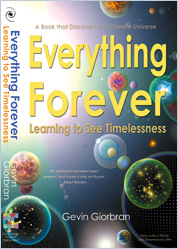
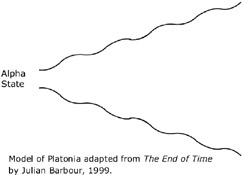
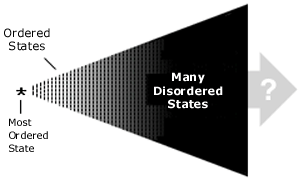 Improving the Wedge Model
Improving the Wedge Model